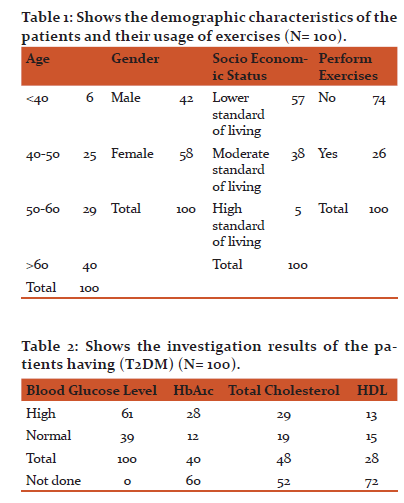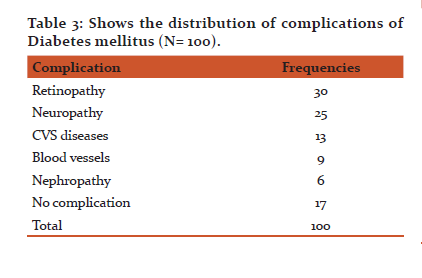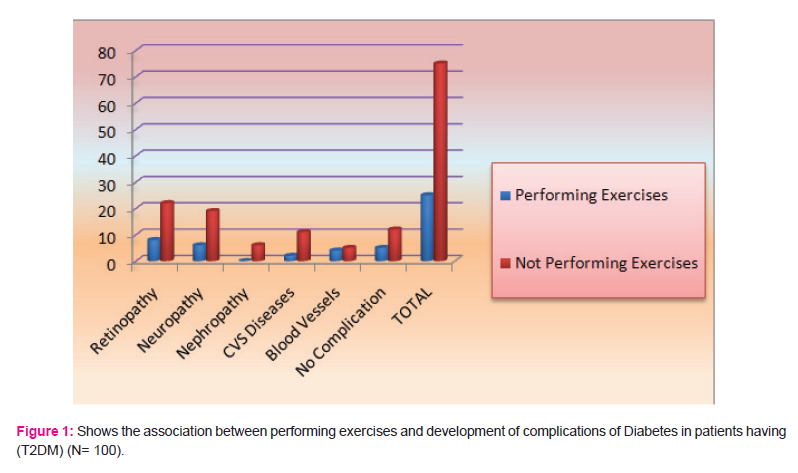IJCRR - 9(8), April, 2017
Pages: 12-16
Date of Publication: 01-May-2017
Print Article
Download XML Download PDF
Association of Physical Activity and Complications of Diabetes among Patients Having Type 2 Diabetes Miletus
Author: Maha Mohammed Bilal, Ahmed Abdella Mohammed Osman, Anoud R. Omer
Category: Healthcare
Abstract:Objective: To assess the physical activities and complications of diabetes among patients having type 2 diabetes mellitus (T2DM).
Methods: We conducted a cross-sectional study inpatients having (T2DM) to measure the effect of physical activity and development of complication among the patients.
Results: Most of patients having (T2DM) were elderly female with the low standard level of living. Just one-quarter of them was performing exercises and they had poor Diabetes control evident by the high blood glucose level the increasing levels of HbA1c,increase levels of total cholesterol and High-Density Lipoprotein. The reported complications included: retinopathy (30 %), neuropathy (25 %), cardiovascular system diseases (13 %), blood vessel diseases (9%) and nephropathy (6 %) respectively.
Conclusions: Physical activity carries significant benefits offered to patients having (T2DM) and there is a need to address physical activity and prescribed it to the patients to prevent, control and postpone the appearance of the complication of the (T2DM).
Keywords: Complication of Diabetes, Physical Activity, Type 2 Diabetes Miletus
Full Text:
Introduction
Nowadays, Diabetes constitutes a widespread epidemic(1). World Health Organization (WHO) data revealed an increase in the number of people having Diabetes from 108 million in 1980 and reaching 422 million in 2014. And it is accounted as a major cause of heart attacks, stroke, blindness, kidney failure and lower limb amputation. The risk factors for Diabetes include insufficient physical activity, rising levels of obesity, and sedentary life(2,3).When Diabetes occurred, a lot of intervention can be undertaken like adequate treatment, regular physical exercises, regular screening and adequate treatment for complications(4).Exercise training carries a lot of benefits extending from improving glucose level, cardiorespiratory fitness, cardiovascular risk, body composition, physical well-being and functioning in patients having (T2DM) or pre-Diabetes(5).
Exercises and Complications of Diabetes
Macrovascular and microvascular complications of Diabetes are prevalent in (T2DM)(6). The long term microvascular complications usually appear in poorly controlled patients. Vascular Disease: Diabetes carries a major risk factor that related to the development of cardiovascular disease. The risk of myocardial infarction (MI) is greater in patients having Diabetes and need to treat and consider seriously(7).
Peripheral Neuropathy: It is a special form of neuropathy that affects the extremities of the patients, more in the lower legs and feet(8,9) it affects patient and leads to loss of distal sensation and the patient will be prone to musculoskeletal injury and infections. Regarding the exercises, it’s recommended that non-weight-bearing training should be applied by patients having peripheral neuropathy in order to relieve trauma and irritation to the lower extremities of the patient(10,11).
Nephropathy: High blood pressure is a well-known complication of Diabetes and it worse kidney functions of the patient(10), but, it needs to be proven whether exercise-induced high blood pressure can lead to the progression of nephropathy. physical activity may help to deal with some factors like blood glucose level and blood pressure, which may lead to the progression of nephropathy in patients having (T2DM)(12,13).
Retinopathy: Although exercise training carries risk of increasing systemic and retinal blood pressures, but some studies found that there were no clear associations between physical activity and the development or progression of proliferative retinopathy(14). Bernbaum and associates(15) revealed that there was an improvement in cardiovascular function(15%) in patients who performed a low-intensity training program and having diabetic proliferative retinopathy. It is recommended that the systolic blood pressure should be limited to 20–30 mm Hg above the baseline in each training session(16).
The Aim of this study was to assess the physical activities that are undertaken by patients having type II diabetes attending the Academy Charity Teaching Hospital (ACTH) in Khartoum State, Sudan 2015.
Methods
This study is a cross-sectional hospital based study conducted during the period from10th June to10th July 2015 in (ACTH) Khartoum, Sudan. We included all patients having (T2DM) and whom were attending (ACTH) during the study period and whom were adult <20 years and having (T2DM) (fasting blood glucose 126 ml/dl, or if he/she on oral anti diabetic drugs). Total number of included subjects was 100 patients having (T2DM). We undertook direct interviews with the patients in the outpatient clinic using pre-coded questionnaire that included socio-demographic data, allocation of physical activities in time and frequency. Then we applied examination of the patients' Blood Pressure, reported the complications of diabetes and obtained the investigations (Fast Blood Sugar FBS, Haemoglobin A1c HbA1c, High Density Lipoprotein (HDL) levels and cholesterol) with routine and standard laboratory procedure.
Data analysis: Data was collected, checked for errors and analysed using statistical package of social sciences SPSS. Frequencies and cross tabulation and presentation of data were performed accordingly.
Ethical consideration:
Before interviewing of any patient, consent was obtained and the collected data were kept confidential. Also a declaration letter from the research committee of Community Department at University of Medical Sciences and Technology were obtained to undertake the study.
Results:
The majority of patients having (T2DM) were elderly female with the low standard level of living. Just one-quarter of them was performing exercises in their lives as shown in table 1. The data showed that the majority of the patients had poor Diabetes control as shown in table 2.Regarding the complications of Diabetes, the data showed that the majority of the patients developed diabetic complications in various pattern; the most obvious complications were Retinopathy followed by Neuropathy, cardiovascular system diseases (CVS), blood vessel diseases and Nephropathy as shown in table 3.We found that performing exercises had statistical significant associations with Blood Glucose Level (p=0.006), level of (HbA1c)(p=0.012) and total Cholesterol levels (p=0.014) as shown in table 4, 5and 6. We found that performing exercises had no statistical significant association with the (HDL) levels (p=0.588) as shown in table 7. The complications of diabetes among the patients not performing exercises regularly were increases more than the patients who performing exercises regularly as shown in figure 1.
Discussion:
In this study, we analysed the data of total number of 100 patients seen in the hospital along period of two months. According to these data, the control of the diabetes exerts a problem with the patients and this poor control was evident by the high blood glucose level and(HbA1c)along with the increased levels of total cholesterol and (HDL).Regarding the development of the complications of Diabetes, it seems to be expected when it compared with the poor control of glucose levels, and these results were corresponding to the previous one (17). The blood glucose, (HbA1c) and total Cholesterol levels of the patients who were performing exercises seem to be more controllable than the patients who didn’t performing regular exercises, and these results match the pervious generated evident(18). On the other hand, (HDL) levels failed to exert a statistical significant association with performing physical exercises. And this may be due to the small portion of the patients performing the blood test for (HDL) levels at this study. These data obviously concentrates in presenting the effects of performing exercises and development of complications of Diabetes in patients having (T2DM) and these data implies the increase numbers of complications of Diabetes in patients not performing exercises regularly in comparison with patients performing exercises. According to these findings, we assume that regular exercises can delay the onset of the onset of the occurrence of the complications of the diabetes in patients having (T2DM).
Conclusion
Physical activity carries significant benefits offered to patients having (T2DM). And there is a need to address physical activity and prescribed it to the patients because the physical activity exerts its beneficial effects in preventing, controlling and post pond the appearance of the complication of the (T2DM). Also, motivation of the patients and follow-up by the health care professionals is required.
Acknowledgement:
Great thank to Professor Zuhair Sharfi for his guidance and support.
Authors acknowledge the immense help received from the scholars whose articles are cited and included in references of this manuscript. The authors are also grateful to authors / editors / publishers of all those articles, journals and books from where the literature for this article has been reviewed and discussed.
Conflicts of interest
The authors declare that there is no conflict of interests.
Source of fund
The authors used self-financial support to undertake this study.






References:
1. Facts F, Diabetes ON. National Diabetes Fact Sheet. Centers Dis Control Prev US Dep Heal Hum Serv. 2011;CS217080A(Division of Diabetes Translation):1–12.
2. Chen L, Magliano DJ, Balkau B, Colagiuri S, Zimmet PZ, Tonkin AM, et al. AUSDRISK: An Australian Type 2 Diabetes Risk Assessment Tool based on demographic, lifestyle and simple anthropometric measures. Med J Aust. 2010;
3. Venables MC, Jeukendrup AE. Physical inactivity and obesity: links with insulin resistance and type 2 diabetes mellitus. Diabetes Metab Res Rev [Internet]. 2009;25(S1):S18--S23. Available from: http://dx.doi.org/10.1002/dmrr.983
4. Balducci S, Iacobellis G, Parisi L, Di Biase N, Calandriello E, Leonetti F, et al. Exercise training can modify the natural history of diabetic peripheral neuropathy. J Diabetes Complications. 2006
5. Snowling NJ, Hopkins WG. Effects of different modes of exercise training on glucose control and risk factors for complications in type 2 diabetic patients: A meta-analysis. Diabetes Care. 2006;29(11):2518–27.
6. Statement C. Role of Cardiovascular Risk. 1989;12(September):573–9. Available from: http://care.diabetesjournals.org/content/diacare/12/8/573.full.pdf
7. Haffner SM, Lehto S, Rönnemaa T, Pyörälä K, Laakso M. Mortality from Coronary Heart Disease in Subjects with Type 2 Diabetes and in Nondiabetic Subjects with and without Prior Myocardial Infarction. N Engl J Med [Internet]. 1998 Jul 23;339(4):229–34. Available from: http://dx.doi.org/10.1056/NEJM199807233390404
8. Albers JW, Brown MB, Sima AAF, Greene DA. Frequency of median mononeuropathy in patients with mild diabetic neuropathy in the Early Diabetes Intervention Trial (EDIT). Muscle and Nerve. 1996;19(2):140–6.
9. Fluckey JD, Hickey MS, Brambrink JK, Hart KK, Alexander K, Craig BW. Effects of resistance exercise on glucose tolerance in normal and glucose-intolerant subjects. J Appl Physiol. 1994;77(3):1087–92.
10. Graham C, Lasko-McCarthey P. Exercise options for persons with diabetic complications. Diabetes Educ. 1990;16(3):212–20.
11. Vinik AI, Erbas T. Recognizing and treating diabetic autonomic neuropathy. Vol. 68, Cleveland Clinic Journal of Medicine. 2001. p. 928–44.
12. Kang J, Robertson RJ, Hagberg JM, Kelley DE, Goss FL, DaSilva SG, et al. Effect of exercise intensity on glucose and insulin metabolism in obese individuals and obese NIDDM patients. Diabetes Care. 1996;19(4):341–9.
13. John L, Rao PS, Kanagasabapathy AS. Rate of progression of albuminuria in type II diabetes. Five-year prospective study from south India. Diabetes Care [Internet]. 1994;17(8):888–90. Available from: http://www.ncbi.nlm.nih.gov/pubmed/7956637
14. Cruickshanks KJ, Moss SE, Klein R, Klein BEK. Physical Activity and the Risk of Progression of Retinopathy or the Development of Proliferative Retinopathy. Ophthalmology [Internet]. 2017 Feb 19;102(8):1177–82. Available from: http://dx.doi.org/10.1016/S0161-6420(95)30893-7
15. Bernbaum M, Albert SG, Brusca SR, Drimmer A, Duckro PN, Cohen JD, et al. A model clinical program for patients with diabetes and vision impairment. Diabetes Educ. 1989;15(4):325–30.
16. Vitug A, Schneider SH, Ruderman NB. Exercise and type I diabetes mellitus. Exerc Sport Sci Rev [Internet]. 1988;16(4):285–304. Available from: http://www.sciencedirect.com/science/article/B7RM4-4G7WH7M-9/2/4f16c4b28561cb3c82d0db402d3035aa
17. Rosengård-Bärlund, Milla, Heikkilä, Outi, Lakka TA, Tikkanen, et al. Physical Activity and Diabetes Complications in Patients With Type 1. Diabetes Care; Feb. 2008;31(2).
18. Colberg SR, Sigal RJ, Fernhall B, Regensteiner JG, Blissmer BJ, Rubin RR, et al. Exercise and type 2 diabetes: The American College of Sports Medicine and the American Diabetes Association: Joint position statement. Diabetes Care. 2010.
|






 This work is licensed under a Creative Commons Attribution-NonCommercial 4.0 International License
This work is licensed under a Creative Commons Attribution-NonCommercial 4.0 International License